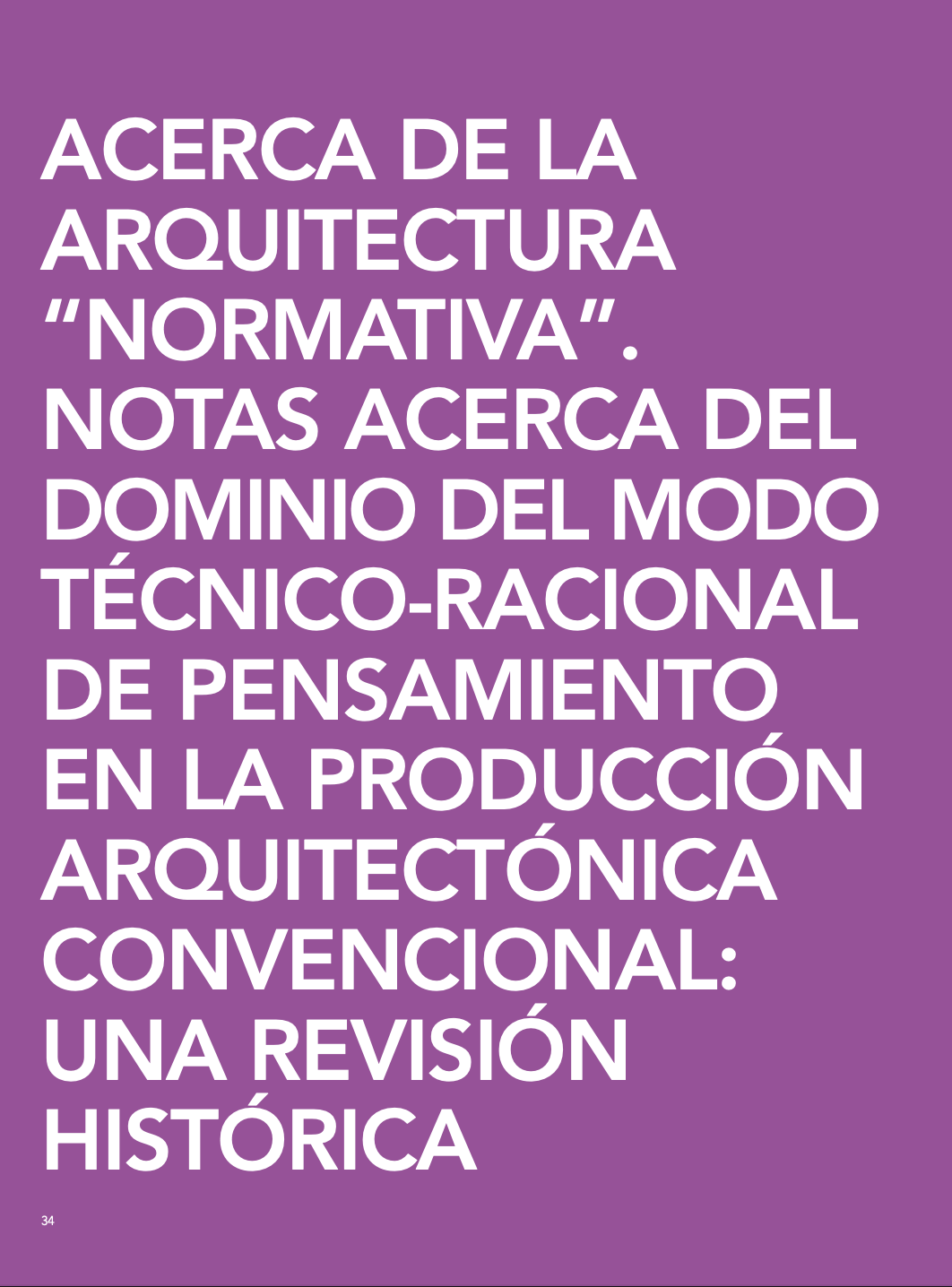ACERCA DE LA ARQUITECTURA “NORMATIVA”. NOTAS ACERCA DEL DOMINIO DEL MODO TÉCNICO-RACIONAL DE PENSAMIENTO EN LA PRODUCCIÓN ARQUITECTÓNICA CONVENCIONAL: UNA REVISIÓN HISTÓRICA
Article Sidebar

Keywords:
Main Article Content
Abstract
El concepto de practica “convencional” o “normativa” se utiliza frecuentemente para describir el modelo de practica de la arquitectura que suele ser generica en sus ambiciones arquitectonicas y tiende a ajustarse a las reglas economicas del mercado. Este modelo de practica sigue lo que podri llamarse una “ideologi tecnico-racional” que tiende a priorizar los discursos de eficiencia, verificacion y entrega rentable y opor- tuna. Este articulo resaltara algunos de los momentos en la historia de la produccion arquitectonica que han pavimentado la vi para el predominio de la ideologi tecnico-racional en la produccion arquitectonica contemporanea, incorporando las ideas de Jean-Nicolas-Louis Durand y Leslie Martin, asi como las que caracterizaron a la corriente de los Design Methods, todas las cuales influyeron en dar forma a la practica arquitectonica convencional. El articulo concluye con especulaciones acerca de la trayectoria futura de la profesion arquitectonica a la luz de la actual prevalencia de esta ideologi.
Article Details
Materia Arquitectura provides immediate and free access to all the content of this online edition, published simultaneously with the print edition.
Materia Arquitectura does not charge authors for any concept.
All contents of this electronic edition are distributed under the Creative Commons license of "Attribución-shareAlike 4.0 Internacional" (CC-BY-SA).
The rights of the published texts and images belong to their authors, who grant Materia Arquitectura the license for their use. The management of the permits and the authorization of the publication of the images (or of any material) that contains copyright and its consequent rights of reproduction in this publication is the sole responsibility of the authors of the articles.
As long as they mention their origin, the authors are free to distribute their articles by other means. Any total or partial reproduction of the material must mention its origin.
Downloads
References
BROSHAR, M., STRONG, N., & FRIEDMAN, D. S. (2010). Report on Integrated Practice [Reporte]. American Institute of Architects.
COLE-COLANDER, C. (2003). Designing the Customer Experience. Building Research & Information, 31(5), 357–366. https://doi.org/10.1080/0961321032000088025
CRINSON, M., & LUBBOCK, J. (1994). Architecture: Art or Profession? Three Hundred Years of Architectural Education in Britain. Manchester University Press.
CUFF, D. (1992). Architecture: The Story of Practice. MIT Press.
Yasser Megahed
DURAND, J. N. L. (1813). Nouveau précis des leçons d’architecture données à l’École imperiale polytechnique. Recuperado de http://archive.org/details/ gri_000133125012233678
FRAMPTON, K. (2007). Modern Architecture: A Critical History. Thames & Hudson.
GUTMAN, R. (1988). Architectural Practice: A Critical View. Princeton Architectural Press.
HILL, S., BRINKLEY, I., JOHAR, I., & FOXELL, S. (2010). Risk, Entrepreneurialism, Practice and the Professional Institute [Building Futures Report]. RIBA.
HACKING, I. (1983). Representing and Intervening: Introductory Topics in the Philosophy of Natural Science. Cambridge University Press.
HUGHES, F. (2014). The Architecture of Error: Matter, Measure, and the Misadventures of Precision. MIT Press.
JENCKS, C. (1987). Le Corbusier and the Tragic View of Architecture. Penguin.
KIERAN, S., & TIMBERLAKE, J. (2003). Refabricating Architecture: How Manufacturing Methodologies are Poised to Transform Building Construction. McGraw-Hill Education.
KOOLHAAS, R., & FOSTER, H. (2013). Junkspace with Running Room. Notting Hill.
LAWSON, B. (2014). How Designers Think: The Design Process Demystified. Routledge.
MARTIN, J. L. (1983). Buildings and Ideas: 1933–1983. Cambridge University Press.
MCELROY, M. (1984). Marketing: How Big Corporations Choose Design Firms. Architectural Record, 172(7), 45 -47.
MCVICAR, M. (2012). God is in the Details’ / ‘The Detail is Moot’: A Meeting Between Mies and Koolhaas. En A. Sharr (Ed.), Reading Architecture and Culture: Researching Buildings, Spaces and Documents (pp. 165-178). Routledge.
MEGAHED, Y., & SHARR, A. (2018). Practiceopolis: From an Imaginary City to a Graphic Novel. Journal of Architectural Education, 72(1), 146–166. https://doi. org/10.1080/10464883.2018.1410670
MURPHY, D. (2016). Last Futures: Nature, Technology and the End of Architecture. Verso.
OMA, KOOLHAAS, R., & MAU, B. (2003). S, M, L, XL (J. Sigler, Ed.). The Monacelli Press.
PÉREZ GÓMEZ, A. (1983). Architecture and the Crises of Modern Science. MIT Press.
PRASAD, S. (2004). Inclusive Maps. En S. Macmillan (Ed.), Designing Better Building: Quality and Value in the Built Environment (pp. 175–184). Taylor & Francis.
ROBINSON, D., JAMIESON, C., WORTHINGTON, J., & COLE, C. (2010). The Future for Architects? [Building Futures Report]. RIBA.
SCHÖN, D. A. (1987). Educating the Reflective Practitioner: Toward a New Design for Teaching and Learning in the Professions. Jossey-Bass.
SCHÖN, D. A. (2017). The Reflective Practitioner: How Professionals Think in Action. Routledge.
SHARR, A. (2010). Leslie Martin and the Science of Architectural Form. En A. Dutoit, J. Odgers, & A. Sharr (Eds.), Quality out of Control: Standards for Measuring Architecture (pp. 67-78). Routledge.
VESELY, D. (2004). Architecture in the Age of Divided Representation: The Question of Creativity in the Shadow of Production. MIT Press.
VILLARI, S. (1990). J.N.L. Durand (1760-1834): Art and Science of Architecture. Rizzoli. WOUDHUYSEN, J., & ABLEY, I. (2004). Why is Construction so Backward? Wiley-Academy.
Most read articles by the same author(s)
- Yasser Megahed, On ‘Normative’ Architecture. Notes on the Domination of the Technical-rational Mode of Thinking on Mainstream Architectural Production: A Historical Highlight , Materia Arquitectura: No. 19 (2020): Materia Arquitectura 19 (Agosto/August 2020)